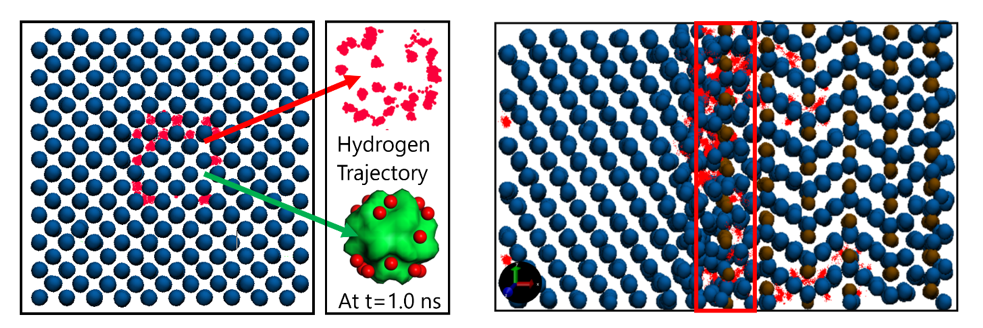Hydrogen embrittlement of steels: a ReaxFF study
Hydrogen embrittlement substantially decreases the mechanical strength of metallic systems, such as carbon steels, often leading to catastrophic failures in these materials. This is a particular problem for materials exposed to hydrogen, in particular the structural iron used in refineries and in oil and gas pipelines.
To gain insight in the mechanisms ultimately leading to material failure, ReaxFF was used to describe the diffusion of hydrogen as well as its chemical interaction with other hydrogen atoms, pure and defective ferrite, and ferrite-cementite interfaces. A grand canonical Monte Carlo (GCMC) scheme was employed to investigate the growth of nanovoids in ferrite phase. The increase in hydrogen concentration at the ferrite-cementite interfaces decreases the work of separation that suggests a hydrogen-induced decohesion behavior. ReaxFF molecular dynamics simulations reproduces the experimental observation of hydrogen accumulation at the interfaces and nanovoids.
These results demonstrate the ability of the ReaxFF potential to elucidate various aspects of hydrogen embrittlement in bcc-iron and hydrogen interactions at a more complex metal/metal carbide interface.

ReaxFF MD simulations for hydrogen trapping at the nanovoids (left) and at the ferrite-cementite interfaces (right)
M. M. Islam, C. Zou, A. C. T. van Duin, and S. Raman, Interactions of hydrogen with the iron and iron carbide interfaces: a ReaxFF molecular dynamics study, Phys. Chem. Chem. Phys. 18 761-771 (2016)
Key conceptsGCMC materials science oil & gas ReaxFF